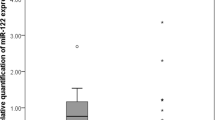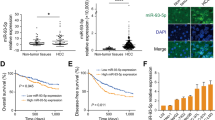Abstract
Growing evidence indicates that microRNAs have a significant role in tumor development and may constitute robust biomarkers for cancer diagnosis and prognosis. In this study, we evaluated the clinical and functional relevance of microRNA-122 (miR-122) expression in human hepatocellular carcinoma (HCC). We report that miR-122 is specifically repressed in a subset of primary tumors that are characterized by poor prognosis. We further show that the loss of miR-122 expression in tumor cells segregates with specific gene expression profiles linked to cancer progression, namely the suppression of hepatic phenotype and the acquisition of invasive properties. We identify liver-enriched transcription factors as central regulatory molecules in the gene networks associated with loss of miR-122, and provide evidence suggesting that miR-122 is under the transcriptional control of HNF1A, HNF3A and HNF3B. We further show that loss of miR-122 results in an increase of cell migration and invasion and that restoration of miR-122 reverses this phenotype. In conclusion, miR-122 is a marker of hepatocyte-specific differentiation and an important determinant in the control of cell migration and invasion. From a clinical point of view, our study emphasizes miR-122 as a diagnostic and prognostic marker for HCC progression.
This is a preview of subscription content, access via your institution
Access options
Subscribe to this journal
Receive 50 print issues and online access
$259.00 per year
only $5.18 per issue
Buy this article
- Purchase on Springer Link
- Instant access to full article PDF
Prices may be subject to local taxes which are calculated during checkout






Similar content being viewed by others
Abbreviations
- HCC:
-
hepatocellular carcinoma
- miRNA:
-
microRNA
References
Ambros V . (2004). The functions of animal microRNAs. Nature 431: 350–355.
Braconi C, Patel T . (2008). MicroRNA expression profiling: a molecular tool for defining the phenotype of hepatocellular tumors. Hepatology 47: 1807–1809.
Budhu A, Jia HL, Forgues M, Liu CG, Goldstein D, Lam A et al. (2008). Identification of metastasis-related microRNAs in hepatocellular carcinoma. Hepatology 47: 897–907.
Calin GA, Sevignani C, Dumitru CD, Hyslop T, Noch E, Yendamuri S et al. (2004). Human microRNA genes are frequently located at fragile sites and genomic regions involved in cancers. Proc Natl Acad Sci USA 101: 2999–3004.
Chang J, Guo JT, Jiang D, Guo H, Taylor JM, Block TM . (2008). Liver-specific microRNA miR-122 enhances the replication of hepatitis C virus in nonhepatic cells. J Virol 82: 8215–8223.
Chang J, Nicolas E, Marks D, Sander C, Lerro A, Buendia MA et al. (2004). miR-122, a mammalian liver-specific microRNA, is processed from hcr mRNA and may downregulate the high affinity cationic amino acid transporter CAT-1. RNA Biol 1: 106–113.
Cheung O, Puri P, Eicken C, Contos MJ, Mirshahi F, Maher JW et al. (2008). Nonalcoholic steatohepatitis is associated with altered hepatic MicroRNA expression. Hepatology 48: 1810–1820.
Coulouarn C, Factor VM, Thorgeirsson SS . (2008). Transforming growth factor-beta gene expression signature in mouse hepatocytes predicts clinical outcome in human cancer. Hepatology 47: 2059–2067.
Coulouarn C, Gomez-Quiroz LE, Lee JS, Kaposi-Novak P, Conner EA, Goldina TA et al. (2006). Oncogene-specific gene expression signatures at preneoplastic stage in mice define distinct mechanisms of hepatocarcinogenesis. Hepatology 44: 1003–1011.
Czech MP . (2006). MicroRNAs as therapeutic targets. N Engl J Med 354: 1194–1195.
El-Serag HB . (2004). Hepatocellular carcinoma: recent trends in the United States. Gastroenterology 127: S27–S34.
Elmen J, Lindow M, Schutz S, Lawrence M, Petri A, Obad S et al. (2008). LNA-mediated microRNA silencing in non-human primates. Nature 452: 896–899.
Esau C, Davis S, Murray SF, Yu XX, Pandey SK et al. (2006). miR-122 regulation of lipid metabolism revealed by in vivo antisense targeting. Cell Metab 3: 87–98.
Esquela-Kerscher A, Slack FJ . (2006). Oncomirs—microRNAs with a role in cancer. Nat Rev Cancer 6: 259–269.
Girard M, Jacquemin E, Munnich A, Lyonnet S, Henrion-Caude A . (2008). miR-122, a paradigm for the role of microRNAs in the liver. J Hepatol 48: 648–656.
Gramantieri L, Ferracin M, Fornari F, Veronese A, Sabbioni S, Liu CG et al. (2007). Cyclin G1 is a target of miR-122a, a microRNA frequently down-regulated in human hepatocellular carcinoma. Cancer Res 67: 6092–6099.
Grise F, Bidaud A, Moreau V . (2009). Rho GTPases in hepatocellular carcinoma. Biochim Biophys Acta 1795: 137–151.
Henke JI, Goergen D, Zheng J, Song Y, Schuttler CG, Fehr C et al. (2008). microRNA-122 stimulates translation of hepatitis C virus RNA. EMBO J 27: 3300–3310.
Jopling CL, Yi M, Lancaster AM, Lemon SM, Sarnow P . (2005). Modulation of hepatitis C virus RNA abundance by a liver-specific MicroRNA. Science 309: 1577–1581.
Kaposi-Novak P, Lee JS, Gomez-Quiroz L, Coulouarn C, Factor VM, Thorgeirsson SS . (2006). Met-regulated expression signature defines a subset of human hepatocellular carcinomas with poor prognosis and aggressive phenotype. J Clin Invest 116: 1582–1595.
Kong W, Yang H, He L, Zhao JJ, Coppola D, Dalton WS et al. (2008). MicroRNA-155 is regulated by the transforming growth factor beta/Smad pathway and contributes to epithelial cell plasticity by targeting RhoA. Mol Cell Biol 28: 6773–6784.
Krutzfeldt J, Rajewsky N, Braich R, Rajeev KG, Tuschl T, Manoharan M et al. (2005). Silencing of microRNAs in vivo with ‘antagomirs’. Nature 438: 685–689.
Kutay H, Bai S, Datta J, Motiwala T, Pogribny I, Frankel W et al. (2006). Downregulation of miR-122 in the rodent and human hepatocellular carcinomas. J Cell Biochem 99: 671–678.
Ladeiro Y, Couchy G, Balabaud C, Bioulac-Sage P, Pelletier L, Rebouissou S et al. (2008). MicroRNA profiling in hepatocellular tumors is associated with clinical features and oncogene/tumor suppressor gene mutations. Hepatology 47: 1955–1963.
Lagos-Quintana M, Rauhut R, Yalcin A, Meyer J, Lendeckel W, Tuschl T . (2002). Identification of tissue-specific microRNAs from mouse. Curr Biol 12: 735–739.
Lee JS, Chu IS, Heo J, Calvisi DF, Sun Z, Roskams T et al. (2004a). Classification and prediction of survival in hepatocellular carcinoma by gene expression profiling. Hepatology 40: 667–676.
Lee JS, Chu IS, Mikaelyan A, Calvisi DF, Heo J, Reddy JK et al. (2004b). Application of comparative functional genomics to identify best-fit mouse models to study human cancer. Nat Genet 36: 1306–1311.
Lee JS, Heo J, Libbrecht L, Chu IS, Kaposi-Novak P, Calvisi DF et al. (2006). A novel prognostic subtype of human hepatocellular carcinoma derived from hepatic progenitor cells. Nat Med 12: 410–416.
Lee JS, Thorgeirsson SS . (2002). Functional and genomic implications of global gene expression profiles in cell lines from human hepatocellular cancer. Hepatology 35: 1134–1143.
Li W, Xie L, He X, Li J, Tu K, Wei L et al. (2008). Diagnostic and prognostic implications of microRNAs in human hepatocellular carcinoma. Int J Cancer 123: 1616–1622.
Lin CJ, Gong HY, Tseng HC, Wang WL, Wu JL . (2008). miR-122 targets an anti-apoptotic gene, Bcl-w, in human hepatocellular carcinoma cell lines. Biochem Biophys Res Commun 375: 315–320.
Lu J, Getz G, Miska EA, varez-Saavedra E, Lamb J, Peck D et al. (2005). MicroRNA expression profiles classify human cancers. Nature 435: 834–838.
Murakami Y, Yasuda T, Saigo K, Urashima T, Toyoda H, Okanoue T et al. (2006). Comprehensive analysis of microRNA expression patterns in hepatocellular carcinoma and non-tumorous tissues. Oncogene 25: 2537–2545.
Odom DT, Zizlsperger N, Gordon DB, Bell GW, Rinaldi NJ, Murray HL et al. (2004). Control of pancreas and liver gene expression by HNF transcription factors. Science 303: 1378–1381.
Parkin DM, Bray F, Ferlay J, Pisani P . (2005). Global cancer statistics, 2002. CA Cancer J Clin 55: 74–108.
Tang X, Gal J, Zhuang X, Wang W, Zhu H, Tang G . (2007). A simple array platform for microRNA analysis and its application in mouse tissues. RNA 13: 1803–1822.
Tavazoie SF, Alarcon C, Oskarsson T, Padua D, Wang Q, Bos PD et al. (2008). Endogenous human microRNAs that suppress breast cancer metastasis. Nature 451: 147–152.
Tsai WC, Hsu PW, Lai TC, Chau GY, Lin CW, Chen CM et al. (2009). MicroRNA-122, a tumor suppressor microRNA that regulates intrahepatic metastasis of hepatocellular carcinoma. Hepatology 49: 1571–1582.
Thorgeirsson SS, Grisham JW . (2002). Molecular pathogenesis of human hepatocellular carcinoma. Nat Genet 31: 339–346.
Thorgeirsson SS, Lee JS, Grisham JW . (2006). Functional genomics of hepatocellular carcinoma. Hepatology 43: S145–S150.
Tzur G, Levy A, Meiri E, Barad O, Spector Y, Bentwich Z et al. (2008). MicroRNA expression patterns and function in endodermal differentiation of human embryonic stem cells. PLoS ONE 3: e3726.
Varnholt H, Drebber U, Schulze F, Wedemeyer I, Schirmacher P, Dienes HP et al. (2008). MicroRNA gene expression profile of hepatitis C virus-associated hepatocellular carcinoma. Hepatology 47: 1223–1232.
Villanueva A, Newell P, Chiang DY, Friedman SL, Llovet JM . (2007). Genomics and signaling pathways in hepatocellular carcinoma. Semin Liver Dis 27: 55–76.
Wong QW, Lung RW, Law PT, Lai PB, Chan KY, To KF et al. (2008). MicroRNA-223 is commonly repressed in hepatocellular carcinoma and potentiates expression of Stathmin1. Gastroenterology 135: 257–269.
Xue W, Krasnitz A, Lucito R, Sordella R, Vanaelst L, Cordon-Cardo C et al. (2008). DLC1 is a chromosome 8p tumor suppressor whose loss promotes hepatocellular carcinoma. Genes Dev 22: 1439–1444.
Yoshioka K, Imamura F, Shinkai K, Miyoshi J, Ogawa H, Mukai M et al. (1995). Participation of rhop21 in serum-dependent invasion by rat ascites hepatoma cells. FEBS Lett 372: 25–28.
Acknowledgements
This project was supported in part by the Intramural Research Program of the Center for Cancer Research.
Author information
Authors and Affiliations
Corresponding author
Additional information
Supplementary Information accompanies the paper on the Oncogene website (http://www.nature.com/onc)
Supplementary information
Rights and permissions
About this article
Cite this article
Coulouarn, C., Factor, V., Andersen, J. et al. Loss of miR-122 expression in liver cancer correlates with suppression of the hepatic phenotype and gain of metastatic properties. Oncogene 28, 3526–3536 (2009). https://doi.org/10.1038/onc.2009.211
Received:
Revised:
Accepted:
Published:
Issue Date:
DOI: https://doi.org/10.1038/onc.2009.211
Keywords
This article is cited by
-
Exosomal microRNAs as biomarkers for viral replication in tofacitinib-treated rheumatoid arthritis patients with hepatitis C
Scientific Reports (2024)
-
Activation of IGFBP4 via unconventional mechanism of miRNA attenuates metastasis of intrahepatic cholangiocarcinoma
Hepatology International (2024)
-
MicroRNA-122 in human cancers: from mechanistic to clinical perspectives
Cancer Cell International (2023)
-
Widespread 8-oxoguanine modifications of miRNA seeds differentially regulate redox-dependent cancer development
Nature Cell Biology (2023)
-
EMT and Inflammation: Crossroads in HCC
Journal of Gastrointestinal Cancer (2023)



